Isaac Levitan (1860 – 1900) was a master Russian painter known mostly for his remarkable and diverse landscapes. He is one of the first artists I look to whenever I am in need of landscape painting inspiration. In this post, I take a closer look at his life and art. In this post, I cover:
- Key Facts About Isaac Levitan
- A Closer Look at Isaac Levitan’s Paintings
- Want to Learn More?
- Thanks for Reading!
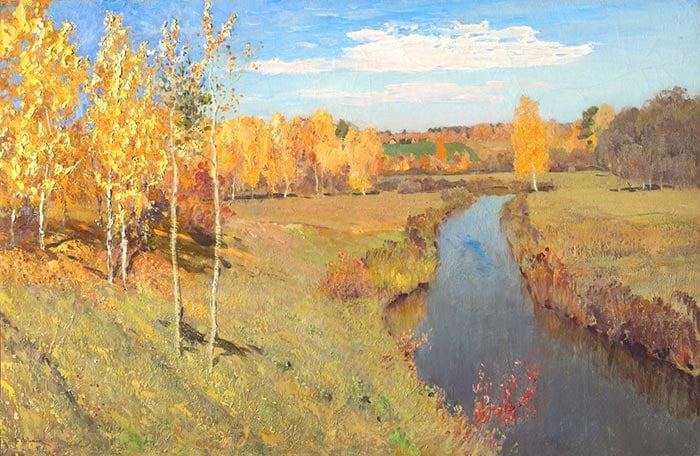
(Before diving into this post, make sure to pick up a copy of my free Landscape Painting Starter Kit.)
Key Facts About Isaac Levitan
- Isaac Levitan was born to a poor Jewish family in Kybartai, which was part of the Russian Empire at the time. Levitan and his family later relocated to Moscow, where Levitan began his artistic studies.
- He enrolled in the Moscow School of Painting, Sculpture and Architecture in 1873. His brother Adolf had already been studying there for two years. Below is a portrait by him featuring a young Isaac Levitan.

- He worked with many other master Russian landscape painters, such as Alexei Savrasov, Vasily Perov, and Vasily Polenov. Below is one of Savrasov’s paintings which shows similarities with Levitan’s work, particularly the subtle colors and delicate brushwork.

- His mother passed in 1875 and his father shortly after in 1877. Levitan slipped into poverty and was basically homeless, spending several nights at the Moscow School of Painting. Due to this hardship and his artistic talents, the School provided him with a scholarship to continue studying.
- In the same year of his father’s death, Levitan started to gain recognition for his work. He exhibited with a group of Russian realist artists who went by the name Peredvizhniki (or the Wanderers). He won two silver medals for his paintings Sunny Day. Springtime (shown below) and Evening and Sunny Day. His painting below, and many of his other early works, lean towards realism and almost feel a bit tight. As he gained experience, he got more relaxed and impressionistic.

- In May 1879, there was an assassination attempt on Alexander II and all Jewish people living in large cities in Russia were ordered to leave. However, at the request of his teachers, collectors, and fans, Levitan was permitted to return to Moscow to continue his artistic endeavors.
- He continued to exhibit his art, paint with other masters like Konstantin Korovin, and continue to gain recognition for his work. Here is a great timeline of his life, which chronicles some of his achievements and travels.
- By the early 1890s, he was internationally famous for his work. He was elected to the Imperial Academy of Arts in 1897 and subsequently named head of the Landscape Studio in 1898.
- He lived a short but fulfilling life, passing away from illness at the relatively young age of 40 in 1900. He suffered from a heart condition for most of his life and it must have taken its toll, along with the hardship he suffered as a child. He left behind no family, but a great legacy and hundreds of artworks which continue to inspire. Below is his last painting, which he was unable to finish:

- He had an asteroid named after him: 3566 Levitan. It was discovered by a Soviet astronomer named Lyudmila Zhuravlyova in 1979.
A Closer Look at Isaac Levitan’s Paintings
One thing you will notice about Levitan’s landscape paintings is how diverse they are in terms of style and subject. His academic training allowed him to be such a versatile painter and, like many of the other Russian masters, it appears he was not timid about experimenting with his style and technique. Some paintings are delicately rendered and realistic, whilst others are bold and impressionistic.
Eternal Rest (below) has a sense of calmness about it. The water appears still and the colors are somber. There is a powerful contrast at the top of the painting, where the sunlight is shooting over the dramatic clouds which line the horizon. The building at the bottom, which appears relatively small and insignificant, gives a sense of scale in the painting.

The painting below is in stark contrast. The colors are rich and you get a sense of the strong sunlight coming from overhead. Blues dominate the painting, with small, orange accents in the distance.
Levitan did a fantastic job with the reflections in the water. Notice how light colors of the clouds are darker in the reflections. You will often find that reflections pull all the colors towards a middle-value range (the lights look a bit darker and the darks look a bit lighter).

I remember first coming across this painting on a website and being stunned by the use of color. It prompted me to explore more into Levitan’s work, which was relatively unknown to me at the time. There is a strong sense of atmospheric perspective in this painting, with the colors getting weaker and cooler as they recede into the distance.

Below is one of Levitan’s pastels, which features beautiful autumn yellows against a dull backdrop of grays and other weak colors.

Blooming Apple Trees is a delicate and complex painting. Levitan was clever in the way he simplified much of the “noise”, but not so much that the subject loses form. For the trees, he picks up the important shadows and branches. He also uses more detail for the nearest trees. The grass, house, and background are really nothing more than simple color shapes.
Also, notice the tight value range which Levitan painted within; most of the painting stays within a high-key (light colors), with a few dark accents scattered throughout.

The painting below shows the importance of negative space. Those gaps in the trees break up an otherwise dark and monotonous area. They also play an important role in giving context and form to the trees.

Below is a pleasant study in gouache by Levitan (he practiced many different mediums, but seems to have specialized in oils). This shows an effective combination of broad washes of color along with line drawing on top.

Below is a great example of taking a complex subject and simplifying it into basic shapes, lines, and colors. You can see parts of the light background through gaps in the trees. The dappled light hitting the grass also provides for a nice feature.

Below is just a small study by Levitan, but it appears incredibly realistic. That is what happens when you get most of the values and important details right.

Silent Abode looks to have been painted just before sunset (or just after sunrise). Levitan used soft, pastel colors for the lights and imposing, near-black colors for the darks: a powerful contrast.
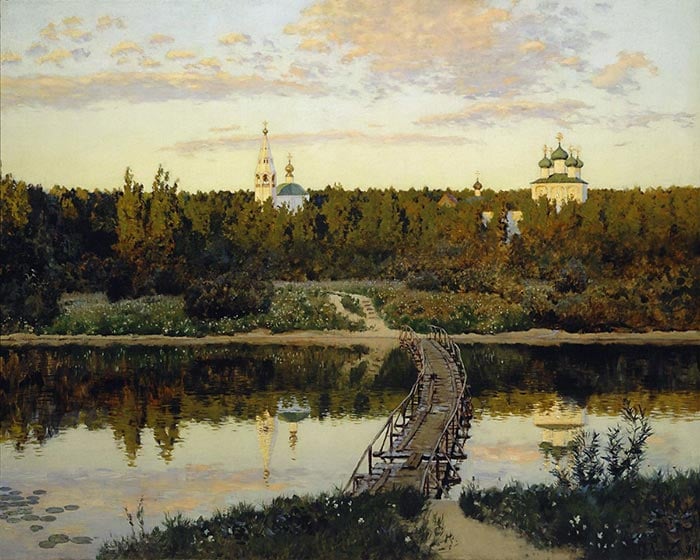
I love the stark contrast between light and shadow in the painting below. It also looks as though Levitan used thick, impasto paint for the lights, contrasted against thin and weak darks.
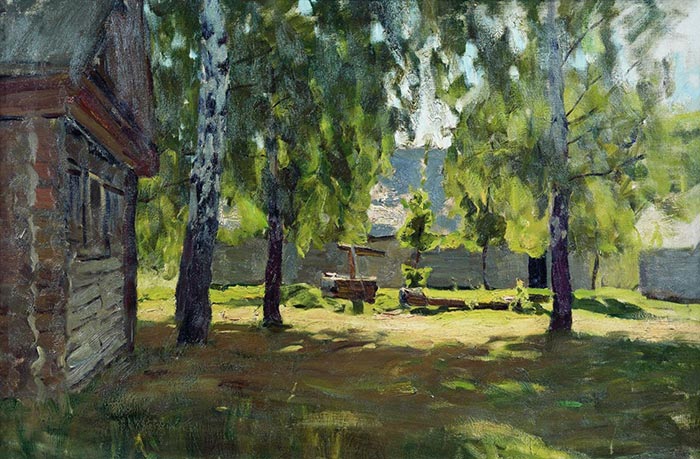
The Trunk of a Blossoming Oak is an interesting composition looking up at an oak tree towards the sky. The strong, black shadows give form to the otherwise basic tree. The background is nothing more than a simple arrangement of green and blue shapes. This mimics the way we see in life: we focus on something and everything else blurs out.
Tip: Make sure you don’t get into a routine with the compositions you paint. Mix it up from time to time. Paint an awkward composition and break the rules.

Want to Learn More?
You might be interested in my Painting Academy course. I’ll walk you through the time-tested fundamentals of painting. It’s perfect for absolute beginner to intermediate painters.
Thanks for Reading!
I appreciate you taking the time to read this post and I hope you found it helpful. Feel free to share it with friends.
Happy painting!
Dan Scott

Draw Paint Academy




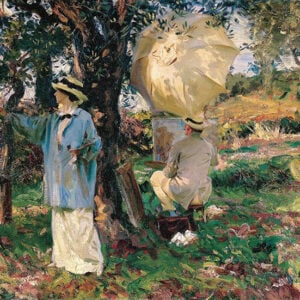

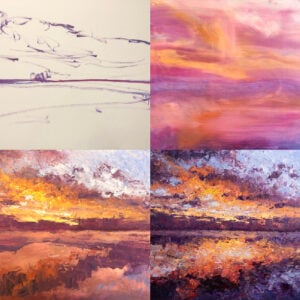
Incredible! Keep them coming!
Thank you for sharing. I have never heard of Isaac Levitan before. Spring in Italy felt like you could breathe the fresh air.
These paintings are unreal! Thank you so much!
Exquisite works!
Levitan is one the the giants of landscape painting so if you have an interest in landscape art he is well worth studying.
Thank you for sharing !
Enjoyed it immensely !
amazing works! thx for sharing!
Love this article! I always find Russian art exquisite.
Dear Dan,
First of all, thank you for your e.mails loaded with interesting illustrations, painting from outstanding painters and accompanied by your always authoritative and helpful comments. I am a Basque retired engineer who two years ago begun painting with a painting professor in a private academy. As I am now working mostly with drawing and watercolouring, I would appreciate if you, from time to time, would include artworks from these disciplines accompanied by your always valued comments. Many thanks and best regards. Juan M. Sansinenea
Learned so much especially shadowing, that I sometimes have trouble with, thanks so much.
I love these paintings, this is the style I’m trying to reproduce.
My favorite is “Sunny Day, Springtime. Never can understand my so many artist go on and on about being loose.
Thank you for sharing, Dan. Greetings from Canada!
Fascinating article, Dan! Thank you for sharing Levitan’s captivating work with us, and for sharing your illuminating and helpful insights. With your articles, you enable me to look at my surroundings, at the world, and at others’ work with fresh perspective. I appreciate your articles: the helpful intention with which you imbue them, the thought you put into them, and the time you take to compose them.
I second that! Thanks!
Thank you Dan for your research and articles. I didn’t know this painter , thanks to you I discover new ones. Very beautiful work!
Hello from Chicago! I so look forward to your posts and I learn a lot simply by closely studying what you point out. I love Levitan’s paintings–I had never seen them before. Learning something new; what a joy! Thank you.
My new favorite artist. Love his work and delicate touch. Thank you for sharing!
Amazing! Very informative article…
I too enjoyed seeing the work and reading description of his approach and life of this Russian artist
This was very informative. Thank you so much.
Great write up. What’s most interesting is the way you explain the paintings. For learners it,’s great to be shown what to see in a painting. it’s also informative to know about painter’s lives. thank you.
I echo all of the above from Vancouver Island and look forward to all further articles. Thanks
His mood is reflected in his paintings. His light use is so great, makes me want to study him. Thank you for sharing this talented artist.
From Vancouver Island. I echo all of the above and look forward to all the future articles,
From Vancouver Island I echo all of the above and look forward to all further articles. Thanks.
Hi Dan, It’s a terrible shame to see someone with so much to offer taken from us so early.
I can only imagine we he could have done with more time.
I guess that’s the frailty of life, don’t know what’s just around the corner.
I appreciate this post as I had never heard of this young man.
Thanks Dan.
Awesome! Really enjoy your website.
Thank you Dan for bringing this Artist, Levitan, to my attention. His work is most appealing to me in style and content and I will do some practice based on some of his paintings. I appreciate all of the work you put into these very informative posts. I enjoy reading them and learning about new artists, (to me anyway), and their style of work.
These are truly inspirational! I too had never heard of Levitan previously and am so glad you ’introduced ‘ us! Such a broad array of mediums and focus. Thank you Dan for this piece on Isaac Levitan.
Happy 4th!
Thanks for posting about one of my favorite landscape painters. My first love was Tonalism but shortly thereafter was so stunned by “Eternal Rest”, and Levitan’s ability to paint beautifully in any style, that he remains at the top of my favorites list! Imagine if he had lived another 40 years?
Thanks for sharing his work! I had never heard of him before, but I love the works of his that you showed and discussed!
well very nice thank you. .. my subscription to your channel is worth of my trust to share my email. .
My favorite landscape artist. Amazed that so many people reading this had not heard of him! The early Russian artists around 1900 are so wonderful, people need to do more research, some wonderful books out there on Russian artists.
I am grateful for seeing this ….Levitan is new to me and his ability relate to us what he experienced on the days that he worked on his paintings is remarkable…..Thank you so much …
Very informative Dan, thanks for the tutorial I’m sure this will help me improve my painting.
Hi Dan,
thank you for introducing me to Levitan. In all my years, I have never heard of him nor seen any of his paintings, or remember seeing any. I can really his style for clouds, mine look like wrinkled pancakes. Will study and practice his style.
Thank you for all your knowledge and sharing it.
Thanks for sharing these paintings. I was not familiar with this Russian painter. His artwork is outstanding!
Jean
Thanks for the introduction to Levitan. Beautiful landscapes. I need to learn more about Russian art, I think.
Great article Dan! Levitan is one of my favorite landscape artists. I’ve seen his original paintings at the Tretyakov Gallery in Moscow! They’re spectacular! Thanks for introducing him on your website.
Thanks so much for such a great history of Levitan the Legend! He’s one of my favourites but your post taught me many new things about his life and work.
This has been an inspirational post. Just wonderful.
I particularly loved Forest and In the Park. It’s tragic that such a great talent passed so young.
Thank you for this!
He was totally brilliant, my favourite. Thank you so much for your comments and help. Feel very inspired. Kind regards Carol
Thank you for inspiring me to research Isaac Levitan further. He IS an outstanding painter of landscapes, so much so that he will be the subject of my monthly Art History class here in the UK. My presentation will be made tomorrow (21/01/2021) but because of COVID 19 will be online via ZOOM. Thank you again.
Would it be possible for me to join your monthly Art History class, Isaac Levitan is one of my very favourite artists and I would love to know more about him and his techniques.
Thank you for introducing me to Isaac Levitan’s work. Your comments made me appreciate them much more.
Best wishes.
Can’t wait to some of this on my own painting
These are all beautiful. Until I saw your post I had never heard of him as an artist but he was exceptionally great. Thank you For sharing it was almost like walking through an art gallery.
Thank you for sharing his beautiful artwork, I have never heard of him before but now I know I will investigate him further. So sad he passed at an early age. Can’t wait to see who you find for us next!
Thanks for sharing about this artist. I really love his work, especially the vibrant sunny landscapes. He was so talented even at a young age. There may have been an error in the timeline. He would have passed away in 1900 at the age of 40.
Thank you Mark! I have fixed it up.
Dan
Eternal Rest is amply named. Such a beautiful painting and one of my favorites. Thanks so much for these master study reviews. They are amazing.
I look forward everyday to your emails! Thank you for sharing. I am going through a slump right now amd can’t seem to get anything right. Your emails inspire me to stick with it.
I heard about Isaac Leviton for the first time but his pictures well represent the Mother Russia esp. Silent Abode with the onion domes of the Russian Orthodox churches on the background. I like his colour palette and how well he expressed the mood from the bright vibrant optimistism to the darkness of the forest (picture Forest).
The picture the Blooming Apple Trees from 1896 caught my attention because a similar picture was painted by Camille Pisarro (I do not know the year) called Plum Trees in Blossom with a tree in the foreground and a building on the background. Sir Winston Churchil had had an inspiration from spring when he painted the alley of trees in blossom in the country.
I think that this artist would be a great one to follow if alive. I like the compositions that are very simple but with a lot of detail where needed. Love his depth perception in many of the paintings. Above all he also keeps the colors to a minimum but uses them to their best advantage.
Great. Especially back lit and dapples shadows
Thank you for this article on Levitan. Wonderful renderings of light and shade, beautiful colours, and lively compositions, drawing us in to his special places. So sad he died young.
Thank you, Dan, for your article has given me the inspiration to look into his work more closely.
Thank you so much for this 🙂 How on earth have I missed this amazing artist? I think it’s true to say that not enough is known about Russian artists generally and, up until now, I have not ‘twigged’ to Levitan. I shall now look up a lot more about him. Some years ago we visited Moscow and went to the Tretyakov Gallery where there surely must be some of his paintings, but they didn’t register on my radar at the time. Thank you for filling in that yawning gap!
thanks for this beautiful article about Isaac Levitan. Gonna to take a closer look of his works.
I feel like I just spent some time outdoors! What wonderful art! I am not sure that I would have ever fallen upon Levitan’s work had it not been for your newsletter, Dan. And I would have really missed out! Thanks so much for this introduction! I am drawn by his perspectives and his obvious love of nature.
Wow, this was a fascinating article. I have never heard of the artist but love his work. This is my favourite
presentation of landscape painting. Your story attached to these articles is fabulous. Thank you for
sharing your insight.
Oh quite beautiful! I confess I have not heard of this incredible artist, so many talented artists that we know so little about.
I am learning so much each day, with it comes frustration and impatience, I call myself the impatient artist, but I do learn each day and am so passionate about Art that I will continue. I started painting 15 years ago, life got busy, but now am working on mastering watercolours, a most frustrating medium but also so fulfilling when it is successful!
Absolutely love your insight and knowledge and your easy teaching. Thank you !
Fantastic overview and commentary. I’ve always loved Levitan’s work. Could you please tell me if some of his landscapes were painted of Ukrainian territory or villages? Which ones? Thank you.
From Nikolay Krymov’s book (translated by chatgpt):
“About Levitan… From the early years of my independent creative life, I was struck by Levitan’s extraordinarily keen vision, his ability to capture moments of the day, and the character of Russian nature. But what fascinated me most about Levitan, especially in the early years of the revolution, was how he skillfully, convincingly, and materially depicted grass, huts, trees, and the sky with broad brushstrokes. Despite meticulously detailing every flower and element of the landscape, I couldn’t achieve the same materiality in different elements of nature.
As I agonized over this problem, I gradually approached the truth. One day, while working on a landscape on a gray day, I lightened the overall tone of the sketch. No matter how hard I tried to accurately capture the details of the landscape, it just didn’t work. Then I realized that the mistake lay in the incorrectly chosen overall tone. In painting, I call tone the degree of a color’s luminosity, and the overall tone is the general darkening or lightening of nature at different times of the day (for instance, the overall tone of twilight is darker than the tone of daytime). Painting is the transmission of visible material by tone plus color. Indeed, when I tested this concept on the best works of Russian and foreign painting, I found that when an artist correctly establishes the overall tone of the painting, everything – objects, land, sky – comes to life authentically. Once the correct overall tone is found, the artist doesn’t need to worry so much about detailing; sometimes just one correct spot is enough to make the image appear as a real object.
Levitan’s landscapes are wonderful precisely because, despite his wide brushwork and artistic freedom, they are incredibly material, airy, and true. The sense of the overall tone in Levitan’s paintings didn’t come immediately. It’s not present in his early works. I believe that his vibrant perception of nature was influenced not by Savrasov, as is commonly said (Savrasov himself often didn’t grasp the overall tone), but probably by Chistyakov. Almost all of Chistyakov’s best students – Repin, Serov, Vrubel – had a keen sense of the overall tone in nature.
Levitan also placed great importance on drawing. In his sketches, he would first outline the contours of the landscape with ink, striving for utmost precision. Levitan knew and often stated that changing the contour changes the object’s tone. That’s why his works so rarely contain errors in drawing; on the contrary, they astonish us with the accuracy of shapes, correctness of perspective, and fidelity to spatial solutions.
Having discovered the fundamental law of realistic representation in nature, I began to think about methods of conveying the overall tone in a painting. However, it proved very difficult because I couldn’t find a fundamental, constant element in the painted scene, a kind of “reference tone” in painting, against which I could measure the strength of tones in each object in nature.
However, I was painting a landscape during the evening. Contemplating this “reference tone,” I lit a match and absentmindedly raised it to eye level. Aiming the match at the bright sunset sky, I noticed that the sunset appeared darker in comparison to the match flame. This led me to search for an object in nature that could merge with the flame of a match. I found that it merged with a white wall illuminated by the sun. This “reference tone” allowed me, through comparison with objects in nature, to see the variety of tones and confirm that all evening tones are generally darker than those of a sunny day. From this, I developed the concept of the overall tone.
In my teaching, I strive to instill this acute perception of tone in my students because I know that people find it more challenging to perceive the tone of an object than its color. To convince students, I often give them a simple task: determine the color and tonal difference between two colored dots. When it comes to color, they can decide immediately, but regarding tone, I always receive extremely confused and inconsistent answers.
In his works, Levitan very accurately, perhaps consciously, knowing this law, conveyed the overall tone in nature. This enabled him to depict moments of the day with exceptional truthfulness. All of his paintings are so diverse in their overall tone that we can immediately identify which day and time he depicted. About painting… This happened in Zvenigorod. One sunny day, I went to paint a motif that interested me. In the field by the road stood a white house with a group of trees nearby. The illuminated house was exceptionally bright. To paint it, I used almost pure whites, with very little yellow paint mixed in, fearing to soil the color of the house, which had taken on a yellowish hue from the sun’s rays. Subsequently, I painted the rest of the landscape accordingly – the road, trees, the light green field, and the blue sky. The next day was cloudy. I decided to create a new sketch of the same motif. When I arrived at the scene, I saw that my house shone as a white spot against the entire landscape. To convey its color, I used pure whites. Then I painted the rest of the landscape accordingly. On another day, I painted the same motif in the evening, at sunset. The house burned with a dazzling orange spot against the landscape. To depict it, I took nearly pure whites, carefully mixing in a very small amount of orange paint, again, fearing to darken the color too much. But when I placed all three sketches side by side, I saw that on a gray day, the house appeared brighter than on a sunny one, and in the evening landscape, the house was painted with a tone equal to that of daytime. For me, this way of painting became clearly deceptive.
… Repin and especially Surikov often painted burning candles in their paintings because they helped them accurately convey the tones of objects and find the overall tone. To appreciate how accurately the best Russian painters felt the overall tone, one should walk through the halls of the Tretyakov Gallery, holding a white sheet of paper against the bright areas of their works. All of this speaks to the fact that when evaluating the artistic quality of paintings, we must first pay attention to the accuracy of the overall tone, the general truthfulness, and the precision in capturing nature.